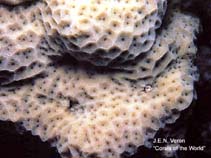Psammocora profundacella Gardiner, 1898
| Native range | All suitable habitat | Point map | Year 2050 |

|
| This map was computer-generated and has not yet been reviewed. |
| Psammocora profundacella AquaMaps Data sources: GBIF OBIS |
Classification / Names Common names | Synonyms | CoL | ITIS | WoRMS
Hexacorallia | Scleractinia | Psammocoridae
Environment: milieu / climate zone / depth range / distribution range Ecology
Reef-associated; depth range 1 - 35 m (Ref. 101928). Tropical; 36°N - 35°S, 180°E - 108°W (Ref. 847)
Distribution Countries | FAO areas | Ecosystems | Occurrences | Introductions
Indo-Pacific: South Africa to Japan, Mexico and Galapagos Islands.
Length at first maturity / Size / Weight / Age
Maturity: Lm ? range ? - ? cm
Short description Morphology
Encrusting. Has a smooth dark blue or brown surface, with no noticeable corallites. Inconspicuous and difficult to be recognized as a coral (Ref. 130769).
Can be found in shallow waters (Ref. 122680). Found in a wide range of reef environments (Ref. 847). On rocky substrates and rubble (Ref. 98471). Occur in both turbid and clear waters. Inconspicuous and difficult to be recognized as a coral (Ref. 130769).
Life cycle and mating behavior Maturity | Reproduction | Spawning | Eggs | Fecundity | Larvae
Members of the class Anthozoa are either gonochoric or hermaphroditic. Mature gametes are shed into the coelenteron and spawned through the mouth. Life cycle: The zygote develops into a planktonic planula larva. Metamorphosis begins with early morphogenesis of tentacles, septa and pharynx before larval settlement on the aboral end.
Main reference
References | Coordinator | Collaborators
Institute of Marine and Coastal Sciences, Rutgers University. 2007. (Ref. 8297)
IUCN Red List Status
(Ref. 130435: Version 2024-2)
Least Concern (LC) ; Date assessed: 27 October 2023
CITES status (Ref. 108899)
Appendix II: International trade monitored
CMS (Ref. 116361)
Not Evaluated
Threat to humans
Human uses
| FishSource |
Tools
More information
Trophic Ecology
Food items
Diet composition
Food consumption
Food rations
Predators
Diet composition
Food consumption
Food rations
Predators
Ecology
Population dynamics
Growth
Max. ages / sizes
Length-weight rel.
Length-length rel.
Length-frequencies
Mass conversion
Recruitment
Abundance
Max. ages / sizes
Length-weight rel.
Length-length rel.
Length-frequencies
Mass conversion
Recruitment
Abundance
Life cycle
Distribution
Human Related
Aquaculture profiles
Stamps, coins, misc.
Stamps, coins, misc.
Outreach
References
Internet sources
BHL | BOLD Systems | CISTI | DiscoverLife | FAO(Publication : search) | Fishipedia | GenBank (genome, nucleotide) | GloBI | Gomexsi | Google Books | Google Scholar | Google | PubMed | Tree of Life | Wikipedia (Go, Search) | Zoological Record
Estimates based on models
Preferred temperature
(Ref. 115969): 24.5 - 29.3, mean 28.4 (based on 3652 cells).
Price category
(Ref. 80766):
Unknown.



